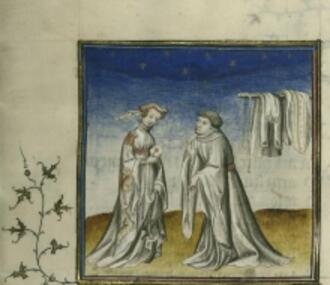La Faculté des Lettres
PAS building room 2401
Read in English
 Detailed manuscript information (based on Roman de la Rose: digital surrogates of medieval manuscripts and Anton von Euw and Joachim M. Plotzek, Die Handschriften der Sammlung Ludwig, Cologne: Schnügen-Museum, 1979-85, vol. 4:228-239.)
Detailed manuscript information (based on Roman de la Rose: digital surrogates of medieval manuscripts and Anton von Euw and Joachim M. Plotzek, Die Handschriften der Sammlung Ludwig, Cologne: Schnügen-Museum, 1979-85, vol. 4:228-239.)
Parchment, measure: 372 x 258mm, 138 folios, two columns, 44 lines.
Scène illustrée
Le sermon et la sentence définitive de Génius: Dame Nature donne une missive à Génius, destinée au Dieu d’Amour et à son armée.
Dimensions:
372x258mm
Miniature de la largeur d’une colonne
Hauteur: 14 vers
Matériaux et couleurs:
Parchemin
Feuille d’or, gris, bleu, marron
Encadrement:
Extérieur: encadrement simple en feuille d’or. Intérieur: encadrement simple et fin, en rouge et bleu. Un simple prolongement en feuille d’or se situe dans le coin gauche du cadre; le prolongement est surmonté d’un “sperme.”
Fond/Paysage:
Sol désertique de couleur marron. Ciel blanc et bleu; en haut du ciel, bleu foncé avec étoiles en or.
Emplacement de la miniature:
Directement avant la confession de Nature
Lieu de production de la miniature:
Paris, France
Date de production de la miniature:
1405
Similitudes avec les autres images du corpus:
Aucunes similitudes
Sources secondaires:
Euw, Anton von et Joachim M. Plotzek. Die Handscriften der Sammlung Ludwig. Cologne: Schnütgen-Museum, 1979-85, vol. 4: 228-239.
Allégories:
Nature est à gauche.
Génius est à droite.
Vêtements et d’autres caractéristiques:
*Semi-grisaille (figures)
1. Nature
Longue houppelande à col montant. Ornée de volants et d’un motif à animaux (un lapin en bas, des renards en haut)
Ceinture dorée
Coiffure réticulée
2. Génius
Longue houppelande
Ceinture
Capuchon
Tête tonsurée
3. D’autres vêtements sont suspendus à une perche, probablement les vêtements sacerdotaux de Génius.
Gestes:
Nature regarde Génius. De la main droite, elle lui donne une missive pour le Dieu d’Amour; de la main gauche, elle tient sa robe. Les mains de Génius sont positionnées comme pour accepter la missive que Nature lui offre.
Paysage:
Tentative de représenter une perspective atmosphérique: un beau ciel bleu avec des étoiles, et un terrain de sol.
Objets:
Deux vêtements blancs sont suspendus dans le coin supérieur droit.
The manuscript belongs to the most beautiful of the approximately three hundred extant Roman de la Rose manuscripts. Furthermore it is, with its 101 column-wide miniature paintings, one of the most richly decorated copies of the text that was so popular from its emergence into the 16th century.
![]() © The J. Paul Getty Museum
© The J. Paul Getty Museum
This work is licensed under a Creative Commons Licence © 2012
La Faculté des Lettres
PAS building room 2401
The University of Waterloo acknowledges that much of our work takes place on the traditional territory of the Neutral, Anishinaabeg, and Haudenosaunee peoples. Our main campus is situated on the Haldimand Tract, the land granted to the Six Nations that includes six miles on each side of the Grand River. Our active work toward reconciliation takes place across our campuses through research, learning, teaching, and community building, and is co-ordinated within the Office of Indigenous Relations.
Select 'Accept all' to agree and continue. You consent to our cookies if you continue to use this website.